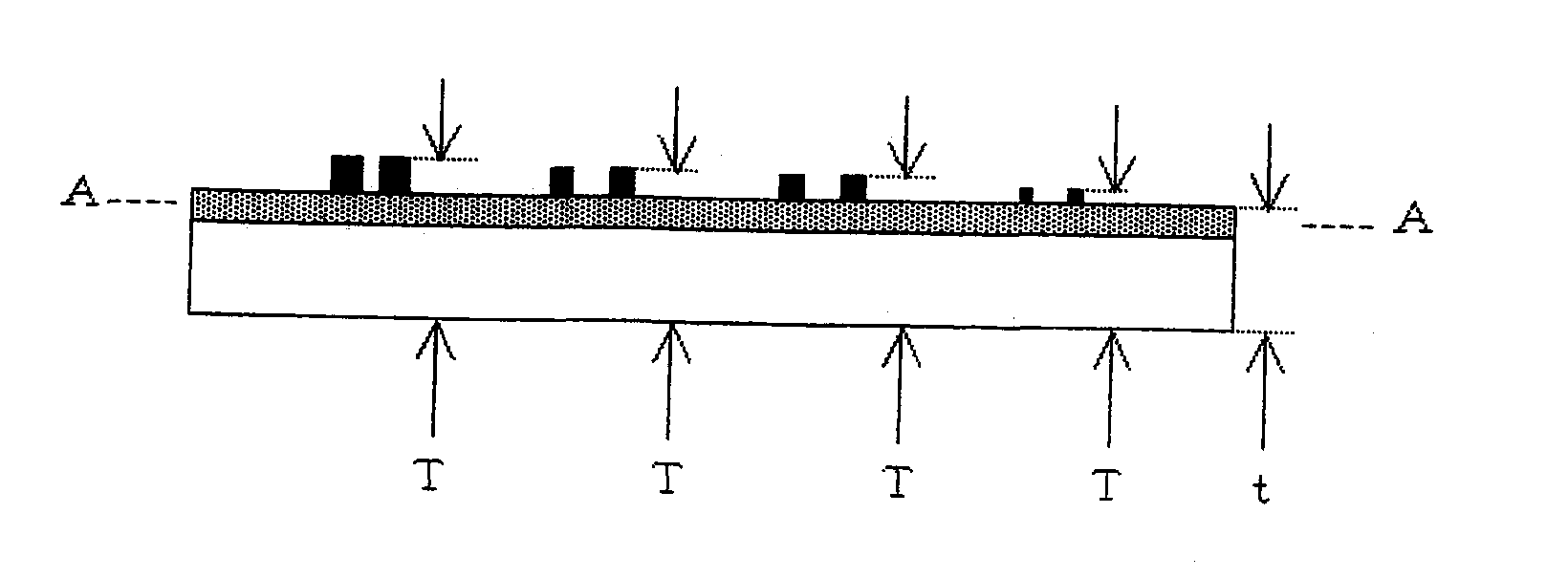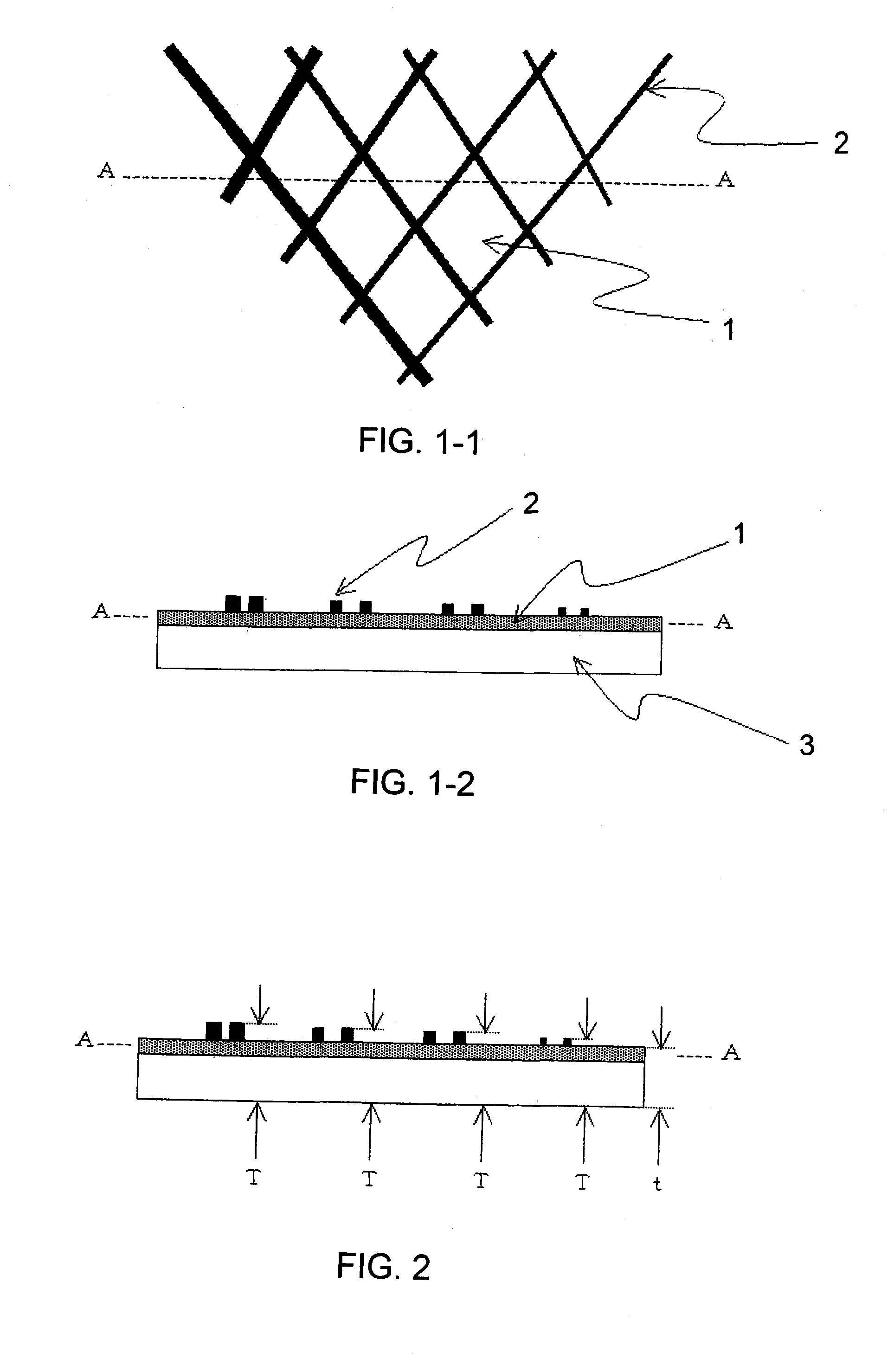Three-dimensionally patterned natural leather
a three-dimensional pattern and natural leather technology, applied in the field of natural leather, can solve the problems of low degree of freedom of three-dimensional patterns capable of being formed, the disappearance of three-dimensional patterns with the lapse of time, and the difficulty of minute three-dimensional expression such as the expression of small dots and thin lines, etc., and achieves high degree of freedom
- Summary
- Abstract
- Description
- Claims
- Application Information
AI Technical Summary
Benefits of technology
Problems solved by technology
Method used
Image
Examples
example 1
(1) Production of Crust
[0097]An adult cow hide was used as a raw hide and was gone through the ordinary process, then was subjected to chromium tanning, squeezing, shaving, re-tanning, neutralizing, dyeing, oiling, samming, drying, conditioning, staking, toggling, trimming, and buffing. The dyeing was carried out so to give the same color as that of the undercoating layer.
(2) Formation of Undercoating Layer
[0098]The materials described in Formulation 1 were mixed with a mixer to prepare a coating material for forming an undercoating layer. At this time, using a cup viscometer (a product of ANEST IWATA Corp.), viscosity was adjusted with a thickener and pure water so as to give a viscosity of 45 seconds.
Formulation 1
[0099]
LCC FF Color YELLOW F3R10 wt parts(pigment, a product of Dainippon Ink And Chemicals,Incorporated)LCC Filler MK-4510 wt parts(anti-tack agent, a product of Dainippon Ink AndChemicals, Incorporated)LCC BINDER SX-70730 wt parts(acryl emulsion, a product of Dainippon I...
example 2
[0106]A three-dimensionally patterned natural leather according to the present invention was fabricated in the same way as in Example 1 except that a coating material of Formulation 3 was used as the resin portion-forming coating material and the amount of resin coating was changed to 20 g / m2. The coating material was found to have a static surface tension at 25° C. of 32.2 dyne / cm. The value obtained by subtracting the static surface tension at 25° C. of the resin portion-forming coating material from the surface free energy at 25° C. of the undercoating layer was 4.6 dyne / cm. The viscosity at 25° C. of the coating material was 90.3 cps and that at 60° C. was 25 cps. Martens hardness of a cured film formed separately was 25 N / mm2. The resin portion thus formed was found to have a maximum thickness of 20 μm.
Formulation 3
[0107]
IRGALITE BLUE GLNF 2 wt parts(copper phthalocyanine pigment, a product of CibaSpecialty Chemicals Inc.)FLOWLEN DOPA-33 1 wt part(dispersant, a modified acrylic...
example 3
[0108]A three-dimensionally patterned natural leather according to the present invention was fabricated in the same way as in Example 1 except that the amount of resin coating was changed to 400 g / m2. The resin portion thus formed was found to have a maximum thickness of 400 μm.
PUM
| Property | Measurement | Unit |
|---|---|---|
| Temperature | aaaaa | aaaaa |
| Length | aaaaa | aaaaa |
| Fraction | aaaaa | aaaaa |
Abstract
Description
Claims
Application Information
 Login to View More
Login to View More - R&D
- Intellectual Property
- Life Sciences
- Materials
- Tech Scout
- Unparalleled Data Quality
- Higher Quality Content
- 60% Fewer Hallucinations
Browse by: Latest US Patents, China's latest patents, Technical Efficacy Thesaurus, Application Domain, Technology Topic, Popular Technical Reports.
© 2025 PatSnap. All rights reserved.Legal|Privacy policy|Modern Slavery Act Transparency Statement|Sitemap|About US| Contact US: help@patsnap.com



